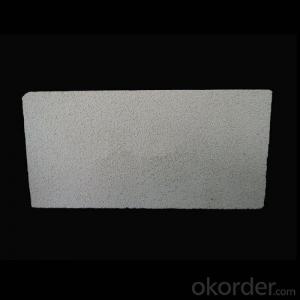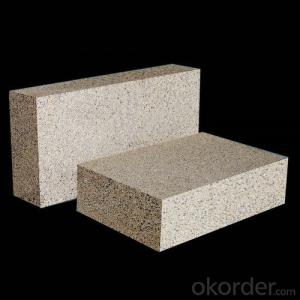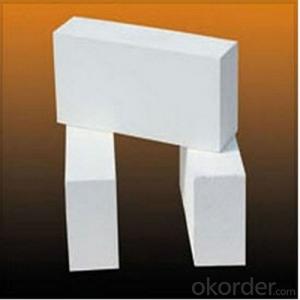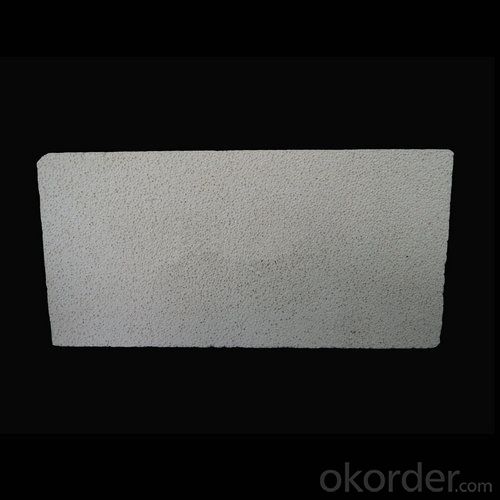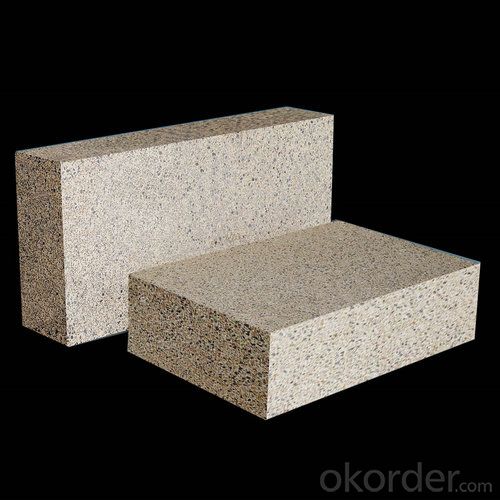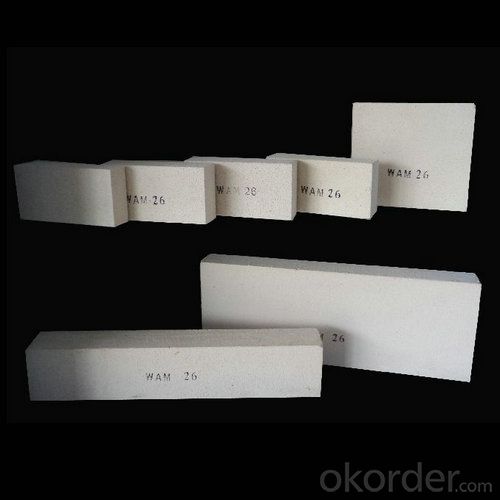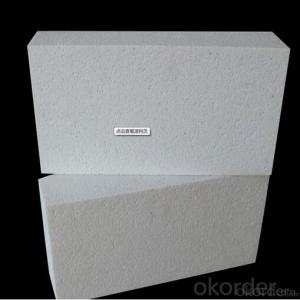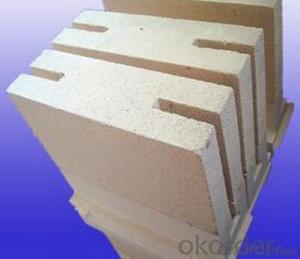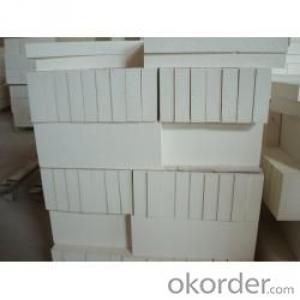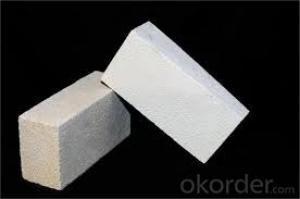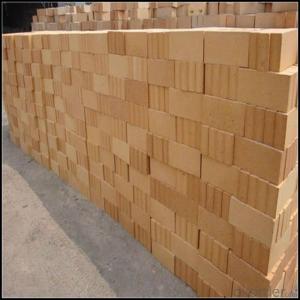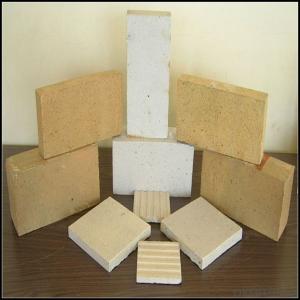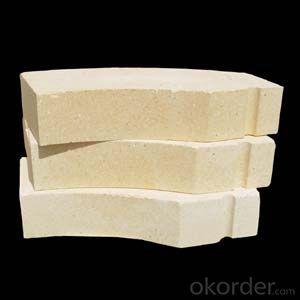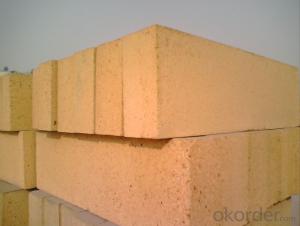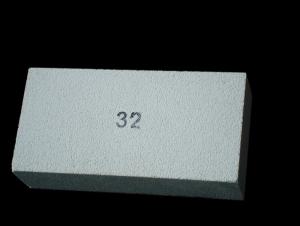High Purity Alumina Clay Insulating Fire Bricks
- Loading Port:
- Tianjin
- Payment Terms:
- TT OR LC
- Min Order Qty:
- 1 m.t.
- Supply Capability:
- 20000 m.t./month
OKorder Service Pledge
OKorder Financial Service
You Might Also Like
Description of Insulating Firebricks
CMAX Insulating Firebricks are classified under temperature between 1300℃ to 1700℃, manufactured from high purity alumina clay.
Features of Insulating Firebricks
Light weight and low thermal conductivity
Low heat storage
Low iron and impurities
High thermal shock resistance
Applications of Insulating Firebricks
CMAX Insulating Firebricks can be used as a hot face lining directly exposed to the heat or as a backup insulation layer in iron and steel mills, non-ferrous foundries, petrochemical, ceramic, glass.
Specifications of Insulating Firebricks
°C Classification Temperature °F | 1260 2300 | 1350 2500 | 1430 2600 | 1540 2600 | 1650 3000 | 1760 3200 | |
ASTM C134-95 g/cm³ Bulk Density ib/ft³ | 0.60 37 | 0.80 50 | 0.80 50 | 0.90 56 | 1.03 64 | 1.25 78 | |
ASTM C133-97 Mpa Cold Crushing Strength ib/in² | 1.2 170 | 2.0 284 | 2.0 284 | 2.6 370 | 2.8 398 | 3.4 484 | |
ASTM C133-97 Mpa Modulus of rupture ib/in² | 0.9 128 | 1.2 170 | 1.5 218 | 1.6 232 | 1.7 247 | 2.0 290 | |
ASTM C210-95 % Permanent Liner Change °C*hrs | 0 1230*24 | -0.5 1350*24 | -0.5 1400*24 | -0.8 1510*24 | -0.9 1620*24 | -0.9 1730*24 | |
ASTM C182-88 Thermal Conductivity (W/m.k) | 400°C | 0.17 | 0.24 | 0.24 | 0.30 | 0.40 | 0.49 |
600°C | 0.19 | 0.28 | 0.27 | 0.32 | 0.42 | 0.50 | |
800°C | 0.22 | 0.32 | 0.30 | 0.35 | 0.44 | 0.51 | |
1000°C | 0.25 | 0.37 | 0.32 | 0.38 | 0.45 | 0.53 | |
1200°C | --- | --- | 0.35 | 0.39 | 0.47 | 0.55 | |
Chemical Analysis of Insulating Firebricks | |||||||
Al2O3 % | 45 | 50 | 55 | 65 | 72 | 76 | |
Fe2O3 % | 0.9 | 0.8 | 0.8 | 0.5 | 0.4 | 0.3 | |
SiO2 % | 50 | 45 | 42 | 32 | 26 | 22 | |
CaO+MgO % | 0.7 | 0.6 | 0.3 | 0.2 | 0.3 | 0.2 | |
K2O+Na2O % | 1.3 | 1.0 | 1.0 | 0.8 | 0.2 | 0.1 | |
Images of Insulating Firebricks
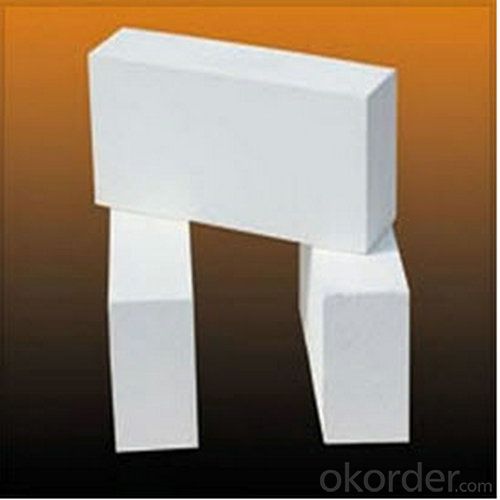

FAQ of Insulating Firebricks
1. Which products do you have?
We have all kinds of refractory brick, castable, mortar, cement, ceramic fiber products, etc.
Or you could browse our products to choose what you need.
2. Can you give me a general idea of the specification and technical data of your products?
CNBM offer a range of refractory and insulation products. We provide refractory bricks, monolithic refractories as well as ceramic fiber products. And On your given shapes, drawings or description, we are producing refractories with all sizes and shapes, resistant to temperature from 800 °C till 1800 °C, using various machines and equipments for cutting, grinding, drilling, polishing, shaping processes.
Every refractory product by CNBM is of superior quality. Lesser refractory products can not approach. CNBM utilizes proprietary testing methods, testing for chemical content, density, apparent porosity, cold crush strength and modulus of rapture. With stringent quality control, you can count on CNBM products to exceed refractory industry standards and your expectations.
3. Can you give me a brief introduction of the application of your products?
We are mainly specializing in the refractory materials in iron and steel, cement, glass, ceramics, petrochemical, electric power Industry, etc.
4. If I need your offer, what information do you need?
In order to choose suitable products, it will be appreciated to provide us the information, such us specification, technical data, order quantity, products application etc.
If any question, please contact us freely.
- Q: Can insulating fire bricks be used for insulation in walls or roofs?
- Insulating fire bricks are primarily designed for use in high-temperature applications, such as furnaces, kilns, and fireplaces. While they offer excellent thermal insulation properties, they may not be the best choice for insulation in walls or roofs of residential or commercial buildings. Insulating fire bricks are often made from lightweight refractory materials, such as ceramic fibers or expanded clay. These materials are highly resistant to heat, but they may not provide sufficient insulation against cold temperatures or moisture. Additionally, their structural integrity may not be suitable for load-bearing applications or other requirements specific to walls or roofs. For insulation in walls or roofs, it is generally recommended to use materials specifically designed for building insulation purposes, such as fiberglass batts, spray foam insulation, or rigid foam boards. These materials are better suited to provide both thermal and moisture resistance, as well as meet the necessary structural requirements. In summary, while insulating fire bricks may offer excellent thermal insulation properties, they are not typically recommended for use in walls or roofs. It is advisable to consult with a building professional or insulation specialist to determine the most suitable insulation materials for your specific needs.
- Q: Do insulating fire bricks expand and contract with temperature changes?
- Insulating fire bricks do indeed undergo expansion and contraction in response to temperature variations. Similar to all other materials, exposure to heat causes these bricks to expand, whereas cooling leads to their contraction. This expansion and contraction phenomenon arises from the material's thermal expansion coefficient, which dictates the degree of expansion or contraction in relation to temperature changes. It is crucial to acknowledge this characteristic when utilizing insulating fire bricks in situations that involve anticipated temperature fluctuations. Neglecting to account for the expansion and contraction may result in structural harm or the formation of cracks.
- Q: Can insulating fire bricks be used as a backup insulation material?
- Yes, insulating fire bricks can be used as a backup insulation material. Insulating fire bricks are designed to have low thermal conductivity, which means they are effective at reducing heat transfer. This makes them suitable for use as a backup insulation material in applications where maintaining temperature stability is crucial. They are commonly used in industrial furnaces, kilns, and other high-temperature environments where the primary insulation material may fail or need additional support. Insulating fire bricks can provide an extra layer of insulation, helping to prevent heat loss and improve energy efficiency. Additionally, they are durable and able to withstand high temperatures, making them a reliable choice for backup insulation.
- Q: What is the refractoriness of insulating fire bricks?
- The refractoriness of insulating fire bricks refers to their ability to withstand high temperatures without losing their structural integrity or undergoing significant thermal expansion. Insulating fire bricks are specifically designed to have a high resistance to heat, making them suitable for applications that involve exposure to extreme temperatures, such as in furnaces, kilns, and fireplaces. The refractoriness of insulating fire bricks is typically measured using the refractoriness under load (RUL) test. This test involves subjecting a sample brick to a predetermined temperature while placing a specified load on it. The RUL is determined by measuring the temperature at which the sample brick exhibits a specified deformation or failure. Insulating fire bricks usually have a high refractoriness, allowing them to withstand temperatures ranging from 1,200 to 1,400 degrees Celsius (2,192 to 2,552 degrees Fahrenheit). This high refractoriness is achieved through the use of special materials and manufacturing techniques that result in a dense and uniform structure with low thermal conductivity. The low thermal conductivity of these bricks helps to minimize heat transfer, making them effective insulators. In addition to their high refractoriness, insulating fire bricks also possess other desirable properties, such as excellent thermal shock resistance, low thermal expansion, and good mechanical strength. These qualities make them ideal for use in applications where maintaining a consistent temperature and preventing heat loss are crucial. Overall, the refractoriness of insulating fire bricks plays a vital role in determining their suitability for high-temperature applications, as it ensures that they can withstand the extreme heat without compromising their structural integrity or insulating properties.
- Q: Do insulating fire bricks require curing after installation?
- No, insulating fire bricks do not require curing after installation. Unlike other types of fire bricks, insulating fire bricks are manufactured using lightweight materials that do not contain moisture or require a curing process. These bricks are designed to provide excellent insulation and heat resistance, making them ideal for applications such as kilns, furnaces, and fireplaces. Once installed, insulating fire bricks can be used immediately without the need for any additional curing or drying time.
- Q: Energy saving bricks or bricks?
- Insulating bricks are mostly hollow or light bricks.It can be said to be energy-saving bricks, including insulation bricks
- Q: Can insulating fire bricks be used as a lining for incinerators?
- Yes, insulating fire bricks can be used as a lining for incinerators. Insulating fire bricks are designed to withstand high temperatures and provide excellent thermal insulation. They are made from lightweight materials such as ceramic fibers, refractory minerals, and binders, which allow them to retain heat and prevent heat transfer to the outer surface. In incinerators, where high temperatures are generated to efficiently burn waste materials, insulating fire bricks can help maintain the desired temperature inside the unit. They can line the walls, floor, and ceiling of the incinerator, helping to contain the heat within the chamber and prevent it from escaping to the surrounding environment. Furthermore, the insulation properties of these bricks can contribute to energy efficiency by reducing heat loss. This can result in lower fuel consumption and operational costs. However, it is important to note that insulating fire bricks may not be suitable for all types of incinerators. Depending on the specific requirements and conditions of the incinerator, other types of refractory materials such as dense fire bricks or castable refractories may be more appropriate. It is advisable to consult with experts or manufacturers to determine the most suitable lining material for a particular incinerator.
- Q: Can insulating fire bricks be used in the construction of glass slump molds?
- Yes, insulating fire bricks can be used in the construction of glass slump molds. These bricks are designed to withstand high temperatures and provide excellent insulation, making them suitable for use in kilns and other heat-intensive applications like glass slumping. Their insulating properties help to maintain a consistent temperature during the slumping process, ensuring the glass molds are formed correctly.
- Q: What is the maximum temperature range of high temperature resistant insulation materials?
- High temperature insulation materials have many, the highest temperature range, specific material.For example, refractory bricks can withstand high temperatures between 1580 and 1770 degrees Celsius
- Q: Can insulating fire bricks be used for insulation in steel mills?
- Insulation in steel mills is possible with the use of insulating fire bricks. These bricks are crafted from lightweight refractory materials that possess exceptional insulating properties and can endure high temperatures. Their purpose is to limit heat transfer and maintain the desired temperature within the furnace or kiln. In the steel mills, these bricks are applicable for insulating the walls, floors, and roofs of the furnaces, ladles, and other equipment. This insulation aids in minimizing heat loss, enhancing energy efficiency, and ensuring consistent and controlled heating processes. Moreover, insulating fire bricks offer thermal stability and safeguard the steel mill equipment against excessive heat, thereby contributing to extended equipment lifespan and reduced maintenance expenses.
Send your message to us
High Purity Alumina Clay Insulating Fire Bricks
- Loading Port:
- Tianjin
- Payment Terms:
- TT OR LC
- Min Order Qty:
- 1 m.t.
- Supply Capability:
- 20000 m.t./month
OKorder Service Pledge
OKorder Financial Service
Similar products
Hot products
Hot Searches
Related keywords
